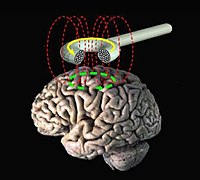
Photo from wikipedia
Background: Activation of venous flow has been shown with different types of electrical stimulation. The aim of this study is to compare the hemodynamic effects of transcutaneous electrical nerve stimulation… Click to show full abstract
Background: Activation of venous flow has been shown with different types of electrical stimulation. The aim of this study is to compare the hemodynamic effects of transcutaneous electrical nerve stimulation (TENS), neuromuscular electrical stimulation (NMES), and sham stimulation on healthy young people. Methods: This randomized crossover study was conducted during June 2018 in the Faculty of Physical Therapy of A Coruña (Spain). Twenty-four university students (50% male) received in a randomized order 5 Hz-TENS, NMES, and sham stimulation on soleus muscle. Flow volume (FV) and peak velocity (PV) from popliteal vein were recorded via Doppler ultrasound, and relative changes from baseline were determined. Discomfort among the 3 stimulations was also compared. Results: The differences among the 3 stimulations were assessed using the ANOVA for repeated measured, the Friedman test and the Kendall tau test, according to the type of measurement to be compared. FV (mL/min) and PV (cm/s) increased significantly after NMES (percentual increase 37.2 ± 62.0%, P = .002; 264.4 ± 152.2%, P < .001, respectively) and TENS (226.2 ± 190.3%, P < .001; 202.7 ± 144.6%, P < .001, respectively). These percentual changes from basal level in hemodynamics were statistically different to those after placebo, which was ineffective enhancing hemodynamics. The improvements in FV were statistically higher with TENS than with NMES (P < .001), but there was no statistical difference in PV (P = .531). Despite NMES was applied at a significantly lower amplitude than TENS (P < .001), NMES protocol was the worst tolerated, though the differences in discomfort were not statistically significant. Conclusion: Both active electrical protocols but not sham stimulation increased hemodynamics in healthy people. TENS obtained higher flow volume increase from baseline than NMES, considered globally at not only in its on-time.
Journal Title: Medicine
Year Published: 2022
Link to full text (if available)
Share on Social Media: Sign Up to like & get
recommendations!